Lance Morcan's Blog, page 12
December 14, 2024
SILVER DAGGER BOOK TOURS a must-visit site for authors!
Silver Dagger Book Tours was founded in September 2016 from the creative mind of Maia, a book blogger extraordinaire who wanted to share her passion for books with new readers. Eight years later and Maia has done over 4,000 tours and worked with hundreds of amazing authors – many who come back for repeat tours! In the interests of full disclosure, I’m one of those authors.
Tours kick off almost every weekday with occasional tours on the weekends and EVERY tour is required to have a giveaway so readers can gain a little something and have fun while they enjoy learning about new books.
Silver Dagger Book Tours accepts all fictional genres and the occasional non-fiction book if it is interesting enough. She works with publishers big and small, indie authors, hybrids, personal assistants and of course authors directly that just want to get a promo boost for their books.
My fellow authors! You can “tour” Silver Dagger Book Tours here: https://www.silverdaggertours.com/ and then email Maia to book YOUR tour at: maia@silverdaggertours.com

Examples of Silver Dagger Book Tours’ current tours feature below.

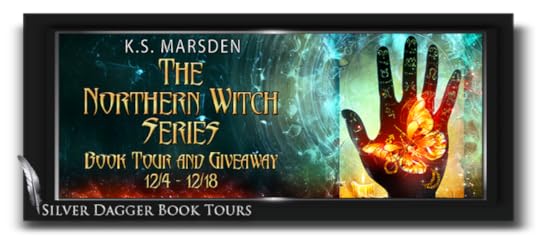


And here’s a bonus for you… SILVER DAGGER BOOK TOURS’ Winter Sale!

https://www.silverdaggertours.com/
************************************************************************
December 13, 2024
Listen up, historical fiction lovers…How’s this for ‘A Darn Good Read’!
A Darn Good Read is the Internet home of Australian historical fiction addict Yvonne and who lives in a tiny rural town in the Eastern Grampians region of Victoria. Do yourself a favour and check it out at https://adarngoodread.blogspot.com/
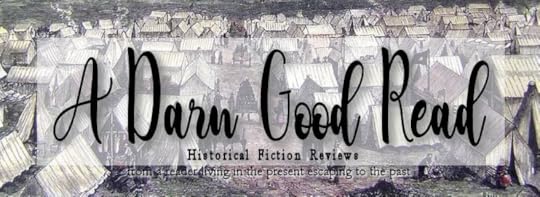
Saturday, December 14, 2024
New Zealand: A Novel – by Lance MorcanSpotlight & Free Kindle Download
December 14th/15th (PST)

This weekend marks the official launch of Lance Morcan’s epic novel New Zealand. In celebration, a free Kindle download is being offered. The promotion will take place over two days, December 14th and 15th (PST). Time converter HERE –
Publication Date: 6 December 2024
Publisher: Sterling Gate Books
Format: Kindle and paperback
Hardcover and audio available early in 2025.
Pages: 391 (print length)
Genre: Historical Fiction
Book Description:
It’s 1768. A chance meeting at London’s dockyards sees medical student Nicholas Young recruited as Surgeon’s Boy to serve under Captain James Cook aboard a bark called the Endeavour. Ahead of the handsome 17-year-old is a voyage that will test his mettle and take him via Tahiti to uncharted places at the bottom of the world. One of those places being a land Dutch explorer Abel Tasman discovered the previous century when he encountered its western shoreline. The land was occupied by tattooed, brown-skinned, warlike people. Tasman called it Nieuw Zeeland.
Nearly five centuries earlier, in 1301 AD, huge, twin-hulled canoes depart the South Pacific Island nation of Hawaiki. Aboard each craft are 80 villagers hand-picked by their rangatira, the mighty Hotu. Raids by enemies from neighbouring islands prompted the decision to flee their homeland. Their destination is a land far to the south. Many weeks later, the survivors aboard Hotu’s canoe sight the eastern shoreline of a rugged land covered by cloud. They call it Aotearoa – land of the long, white cloud.
In 1769, eight months after departing England, Nicholas Young and his crewmates arrive in Tahiti aboard the Endeavour. The Surgeon’s Boy is quickly becoming a man; the journey out was a baptism of fire for him with mid-Atlantic storms resulting in injury and death. In Tahiti, Captain Cook puts his men to work, building an observation post from which he can observe the transit of Venus. Nicholas is excused from shore duties after a local priest, Tupaia, informs Cook that Tahiti’s beautiful queen, Obadia, has invited his Surgeon’s Boy to stay in the village as her guest. Tupaia didn’t mention he convinced the childless queen that Nicholas had been sent to her by the spirits of her ancestors and that he would give her a son. The beautiful queen seduces a surprised but delighted Nicholas, and in the weeks that follow they enjoy long days and nights of lovemaking.
It’s 1501 AD and for the first time the hills of Aotearoa echo to the sounds of war. As the competition for food and land increases, so too does inter-tribal fighting between tribes of the brown-skinned people who now call themselves Maori. Apera, chief of the Te Arawa tribe, leads a war party down the east coast, attacking settlements along the way. Defeated warriors are either enslaved or eaten for cannibalism is widely practised.
October 1769. It’s springtime in Aotearoa. Aboard the Endeavour, Nicholas serves as lookout in the bark’s crow’s nest. Many long weeks have passed since leaving Tahiti. He spies land and shouts, “Land ahoy!” He’s looking at a headland that extends far out into the blue Pacific. So delighted is Cook by the sighting, he names the landmark Young Nick’s Head after his keen-eyed lookout. The captain suspects it’s part of the eastern shoreline of the land Abel Tasman called Nieuw Zeeland. Translating the Dutch to English, Cook renames it New Zealand.
At the same time, a young Maori sits alone on a sandy beach, looking out across a sparkling bay. On his right is the same headland Nicholas spied moments earlier. Moki is the oldest son of the chief of the Ngati Porou tribe and is a proud descendant of Hotu whose battered canoe arrived on this same beach centuries earlier. Moki suddenly jumps to his feet when he sees a tall ship far out to sea. Mistaking its billowing sails for the wings of a giant seabird, he flees inland to his nearby pa, or fortified village, to alert the villagers to the approaching danger.
After anchoring in the bay, Cook dispatches a contingent of his marines ashore. Nicholas and his crewmates look on as the marines are greeted by an impassioned haka, or war dance, performed by Ngati Porou warriors armed with clubs, spears and other Stone Age weapons. The chief’s brother is killed and several warriors wounded in the inevitable violence that follows. So disillusioned is Cook by the conflict, and by the region’s scarcity of wild game, he later names it Poverty Bay.
This first bloody encounter with New Zealand’s indigenous people is a sobering harbinger for what follows.
The Endeavour’s subsequent circumnavigation of the new land is an experience that breaks some men. Amidst the life-threatening challenges they face at sea and on land, Nicholas finds true love when he meets Anika, a beautiful Maori wahine who steals his heart.
Meet the Author: For more information about Lance Morcan and his writing, visit his Amazon Author Page or visit his blog.
*
Posted by Yvonne of A Darn Good Read Saturday, December 14, 2024
Labels: Book Promotion, Historical Fiction, New Zealand, Spotlight
Yvonne’s credentials in her own words: “I don’t have a university degree or anything like that. I just love to read, so I hope my comments, good or bad, will inspire you to grab a book, a cup of your favourite brew and get reading!”
***********************************************************************
Attn. historical fiction lovers! ‘New Zealand: A Novel’ is FREE on Kindle all weekend
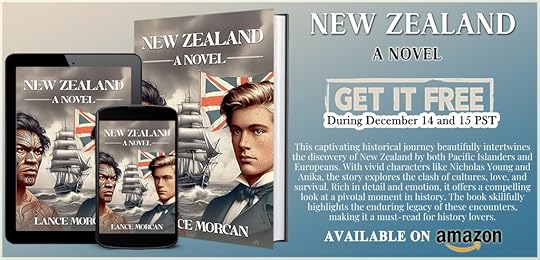
Kindle link: https://www.amazon.com/New-Zealand-Novel-Lance-Morcan-ebook/dp/B0DPTJTDCQ/
****************************************************************
December 12, 2024
‘New Zealand: A Novel’ is FREE on Kindle this weekend Dec. 14 & 15 PST

To celebrate the launch of my epic historical adventure New Zealand: A Novel, it’s free to download on Kindle on Saturday and Sunday December 14 and 15 PST.
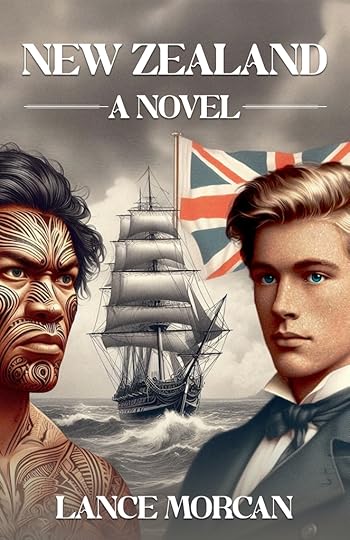
New Zealand: A Novel spans almost 500 years and covers the respective discoveries of New Zealand by Pacific Islanders and Europeans. From the outset the two stories are interposed. It starts in the 1300’s with the departure of Islanders from Hawaiki in search of land far to the south.
The hardy, brown-skinned people who arrive here first call themselves Maori and they call their new home Aotearoa – land of the long, white cloud. The fascinating, eventful and sometimes violent lives of descendants of those first arrivals are traced through the centuries until the arrival of Europeans aboard Captain James Cook’s bark the Endeavour. Cook names the new land New Zealand.
Maoris call the white intruders pakeha. Their arrival heralds a clash of two vastly different ideologies as European civilization collides head on with indigenous culture.
The misunderstandings, tension and bloodshed that follow are relayed as seen through the eyes of one of the Endeavour’s youngest and most engaging crewmembers, Surgeon’s Assistant Nicholas Young, as the vessel embarks on its historic circumnavigation of the country.
Amidst the life-threatening challenges Nicholas faces at sea and on land, the young man finds true love when he meets Anika, a beautiful Maori princess who steals his heart.
*
This novel is also available via Amazon as a paperback and will soon be available as a hardcover and audiobook.
**************************************************************************
December 11, 2024
New release book the ideal Christmas gift for lovers of historical novels
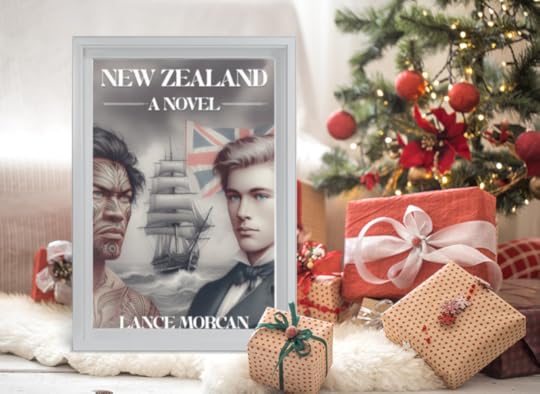
Image courtesy of book blogger extraordinaire Mary Ann Bernal @BritonandDane
Readers and bookworms, for all your historical, science fiction, adventure, short story and novella reading needs, do yourself a favor and visit Mary Ann Bernal’s fabulous online bookstore at: https://maryannbernal.blogspot.com/

And while you’re there, check out Mary’s generous promotion of my new release historical adventure New Zealand: A Novel at: https://maryannbernal.blogspot.com/2024/12/new-release-new-zealand-novel-by-lance.html
**********************************************************
So, you’re into romance novels, huh? Check out RNG… It has romance novel giveaways galore!

Romance Novel Giveaways has a myriad of giveways, gift cards and competitions on its addictive site! Pay it a visit and be prepared to be blown away!
https://www.romancenovelgiveaways.com
And meet Lauren, the special lady behind RNG >>>

“A former Bankruptcy paralegal enduring Stargardt Disease, I am now a proud Wal-Mart Associate with a passion for cheering on my Cleveland Browns (hey, there’s always next year), binge-watching Star Trek: The Next Generation and, of course, reading!
“Launched in August of 2013, Romance Novel Giveaways has been providing quality promotional blog posts for authors in the adult-romance novel genre ever since.
“Each and every blog post contains either a free eBook or a giveaway aimed at the adult-romance novel audience.”
Last but not least, the new release historical adventure-romance New Zealand: A Novel, by Lance Morcan (that’s me!) features as a giveaway in RNG. Be in to win a Kindle-gifted copy of this epic. The competition closes soon.
This blog post contains affiliate links. Click Here for details.

“Coming soon!
NEW ZEALAND: A NOVEL – For lovers of historical fiction, historical romance, lust and adventure”
**************************************************************
December 9, 2024
Historical adventure-romance ‘New Zealand: A Novel’ FREE on Kindle December 14 & 15
To mark this week’s launch of my historical adventure-romance New Zealand: A Novel, the Kindle version will be free to download on the weekend of December 14 & 15 PST.
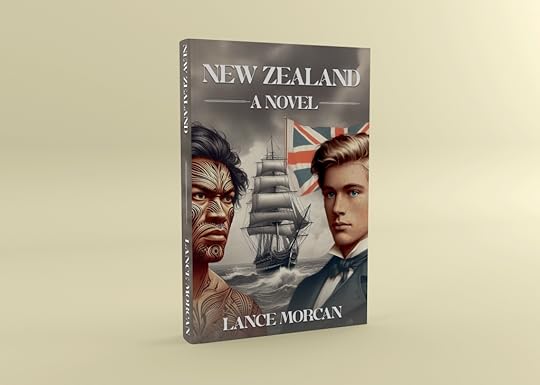
The Kindle link is: https://www.amazon.com/New-Zealand-Novel-Lance-Morcan-ebook/dp/B0DPTJTDCQ
This novel is also available now as a paperback and in early 2025 will be available as a hardcover and audiobook.
The paperback link is: https://www.amazon.com/New-Zealand-Novel-Lance-Morcan/dp/0473728524/
*********************************************************************
Attn. historical fiction lovers! ‘New Zealand: A Novel’ is FREE on Kindle December 10
To mark this week’s launch of my historical adventure-romance New Zealand: A Novel, the Kindle version is free to download on December 10 and again on the weekend of December 14 & 15 PST.

The Kindle link is: https://www.amazon.com/New-Zealand-Novel-Lance-Morcan-ebook/dp/B0DPTJTDCQ
This novel is also available now as a paperback and in early 2025 will be available as a hardcover and audiobook.
The paperback link is: https://www.amazon.com/New-Zealand-Novel-Lance-Morcan/dp/0473728524/
*********************************************************************
December 7, 2024
Historical adventure ‘New Zealand: A Novel’ launched on Amazon
New Zealand: A Novel, by Kiwi author Lance Morcan, has been launched as a Kindle ebook and publication of the paperback version is imminent. Both versions are exclusive to Amazon.

Amazon link: https://www.amazon.com/dp/B0DPTJTDCQ/
Morcan says New Zealand: A Novel was literally half a century in the making. “It has been a labour of love for 50 years now. I recall, back in 1975, writing a logline for a novel about the discovery of New Zealand first by Maori and then by Europeans. I’ve chipped away at it ever since.”
For Morcan, this is his first solo-authored novel. He usually writes in collaboration with his son James, and together they’ve co-authored about 35 published books both fiction and non-fiction. Several have been regular visitors to Amazon’s bestseller lists over the years. These include their historical novels White Spirit, Fiji: A Novel and Into the Americas, their international thriller The Ninth Orphan and their non-fiction books Genius Intelligence and The Catcher in the Rye Enigma.
Synopsis for New Zealand: A Novel follows:
It’s 1768. A chance meeting at London’s dockyards sees medical student Nicholas Young recruited as Surgeon’s Boy to serve under Captain James Cook aboard a bark called the Endeavour. Ahead of the handsome 17-year-old is a voyage that will test his mettle and take him via Tahiti to uncharted places at the bottom of the world. One of those places being a land Dutch explorer Abel Tasman discovered the previous century when he encountered its western shoreline. The land was occupied by tattooed, brown-skinned, warlike people. Tasman called it Nieuw Zeeland.
Nearly five centuries earlier, in 1301 AD, huge, twin-hulled canoes depart the South Pacific Island nation of Hawaiki. Aboard each craft are 80 villagers hand-picked by their rangatira, the mighty Hotu. Raids by enemies from neighbouring islands prompted the decision to flee their homeland. Their destination is a land far to the south. Many weeks later, the survivors aboard Hotu’s canoe sight the eastern shoreline of a rugged land covered by cloud. They call it Aotearoa – land of the long, white cloud.
In 1769, eight months after departing England, Nicholas Young and his crewmates arrive in Tahiti aboard the Endeavour. The Surgeon’s Boy is quickly becoming a man; the journey out was a baptism of fire for him with mid-Atlantic storms resulting in injury and death. In Tahiti, Captain Cook puts his men to work, building an observation post from which he can observe the transit of Venus. Nicholas is excused from shore duties after a local priest, Tupaia, informs Cook that Tahiti’s beautiful queen, Obadia, has invited his Surgeon’s Boy to stay in the village as her guest. Tupaia didn’t mention he convinced the childless queen that Nicholas had been sent to her by the spirits of her ancestors and that he would give her a son. The beautiful queen seduces a surprised but delighted Nicholas, and in the weeks that follow they enjoy long days and nights of lovemaking.
It’s 1501 AD and for the first time the hills of Aotearoa echo to the sounds of war. As the competition for food and land increases, so too does inter-tribal fighting between tribes of the brown-skinned people who now call themselves Maori. Apera, chief of the Te Arawa tribe, leads a war party down the east coast, attacking settlements along the way. Defeated warriors are either enslaved or eaten for cannibalism is widely practised.
October 1769. It’s springtime in Aotearoa. Aboard the Endeavour, Nicholas serves as lookout in the bark’s crow’s nest. Many long weeks have passed since leaving Tahiti. He spies land and shouts, “Land ahoy!” He’s looking at a headland that extends far out into the blue Pacific. So delighted is Cook by the sighting, he names the landmark Young Nick’s Head after his keen-eyed lookout. The captain suspects it’s part of the eastern shoreline of the land Abel Tasman called Nieuw Zeeland. Translating the Dutch to English, Cook renames it New Zealand.
At the same time, a young Maori sits alone on a sandy beach, looking out across a sparkling bay. On his right is the same headland Nicholas spied moments earlier. Moki is the oldest son of the chief of the Ngati Porou tribe and is a proud descendant of Hotu whose battered canoe arrived on this same beach centuries earlier. Moki suddenly jumps to his feet when he sees a tall ship far out to sea. Mistaking its billowing sails for the wings of a giant seabird, he flees inland to his nearby pa, or fortified village, to alert the villagers to the approaching danger.
After anchoring in the bay, Cook dispatches a contingent of his marines ashore. Nicholas and his crewmates look on as the marines are greeted by an impassioned haka, or war dance, performed by Ngati Porou warriors armed with clubs, spears and other Stone Age weapons. The chief’s brother is killed and several warriors wounded in the inevitable violence that follows. So disillusioned is Cook by the conflict, and by the region’s scarcity of wild game, he later names it Poverty Bay.
This first bloody encounter with New Zealand’s indigenous people is a sobering harbinger for what follows.
The Endeavour’s subsequent circumnavigation of the new land is an experience that breaks some men. Amidst the life-threatening challenges they face at sea and on land, Nicholas finds true love when he meets Anika, a beautiful Maori wahine who steals his heart.
*
Publication of the hardcover and audiobook versions of New Zealand: A Novel will follow in early 2025.
***************************************************
December 5, 2024
Final days before launch of my historical adventure epic ‘New Zealand: A Novel’ on Amazon!
Shrouded in cloud at the bottom of the world, this was the land that time forgot: the last sizeable piece of undiscovered land on Earth. Two hundred million years after breaking away from the vast southern continent of Gondwana, Man had yet to leave his footprints on this prehistoric place.
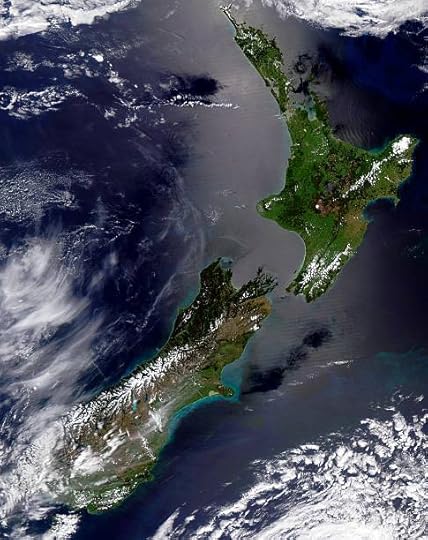
Mythology would have it the land was fished up out of the ocean. In fact, earthquakes and volcanic activity forced it to literally erupt from the seabed. This violent birth left it with a majestic ruggedness that would always reflect its former turbulence.
Over time, its features softened. Scenes of beauty emerged out of the mists. There was a haunting stillness about the land. It was a place of mystery – of magical forests and sparkling lakes and rivers. And the sea surrounded it like some huge tidal moat.
Its isolation ensured it wouldn’t be until well into the First Millennium AD that Man would step foot on these shores. The hardy, brown-skinned people who arrived here called themselves Maori and they called their new home Aotearoa – land of the long, white cloud.
Not until its rediscovery centuries later by European explorers would the land receive the name by which it is known today: New Zealand. Their arrival would herald a clash of two vastly different ideologies as European civilization collided with indigenous culture.
It was a time of conflict, lust and adventure.
*
You’ve been reading the blurb for New Zealand: A Novel. It’s a tale of treachery, lust and conflict. It spans almost 500 years and covers the respective discoveries of New Zealand by Pacific Islanders and Europeans. From the outset the two stories are interposed. It starts in the 1300’s with the departure of Islanders from Hawaiki in search of land far to the south.
Coming soon!
View the novel on Goodreads: https://www.goodreads.com/book/show/221413728-new-zealand
*******************************************************************

 Pre-Release Sneak Peek and EXCLUSIVE eBook Giveaway
Pre-Release Sneak Peek and EXCLUSIVE eBook Giveaway 

